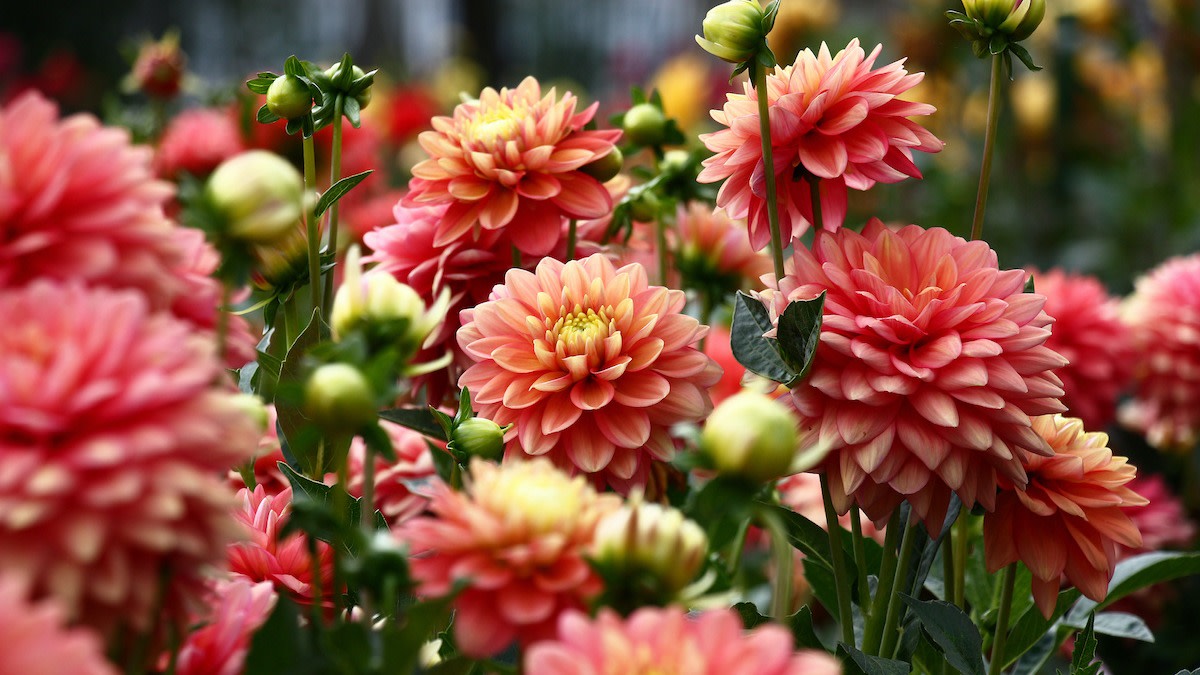How to Grow Dahlias in Your Flower Garden
Written by MasterClass
Last updated: Jun 7, 2021 • 4 min read
Dahlias not only make a colorful addition to a flower garden but are one of the most dazzling and long-lasting cut flowers.
Learn From the Best
What Are Dahlias?
Dahlias are a tuberous plant native to Central America and Mexico. Dahlia flowers come in a range of colors and sizes, including the popular waterlily, collarette, pompon, peony, and cactus dahlia varieties. Smaller bedding dahlias have flowers that are only a few inches wide, while taller dinner plate dahlias can grow blooms up to 15 inches in diameter.
Though dahlias are a perennial plant, they can only survive the winter in USDA hardiness zones 8 to 11, and gardeners often grow them as annuals in other climate zones.
How to Plant Dahlias
Planting dahlias is a straightforward process as long as you follow the proper guidelines.
- 1. Choose healthy dahlia tubers. When buying dahlia tubers at your local garden center, look for ones with pink buds and a tiny bit of green growth, and avoid any with a wrinkled appearance.
- 2. Plant dahlia tubers in late spring. Dahlias flounder in cold weather and require a ground temperature of at least 60 degrees Fahrenheit, so make sure you plant them outdoors after the last frost date. You can also start dahlias indoors four to six weeks before the last frost and then transplant them outside. If starting dahlias indoors in a container, plant dahlia tubers two inches deep in a soilless potting mix, and wait until you see new growth before you water.
- 3. Choose a sunny location with wind protection. In most climates, dahlias thrive in full sun conditions and require six to eight hours of direct sunlight. In hotter climates (USDA hardiness zones 8 to 11), it's best to give dahlias some afternoon shade to keep them from getting overheated during the hottest part of the day.
- 4. Plant dahlias in rich, well-drained soil. Dahlias grow best in slightly acidic soil with a pH between 6.5 to 7.0. If your soil is high in clay content, try working in some peat moss or sand to loosen it up and provide better drainage. You can also use bone meal to add nutrients to the soil
- 5. Give dahlia plants plenty of space. Plant smaller bedding dahlias eight to 12 inches apart. Larger dinner plate dahlia varieties may need two to three feet of space.
- 6. Bury dahlia tubers in stages. Dig a hole about eight inches deep and slightly larger than the dahlia bulb's root ball. Place the bulb inside with its eyes (buds) facing upwards, and cover it with about two inches of soil; once it begins to sprout, fill the rest of the hole.
- 7. Stake taller dahlia cultivars. Staking taller dahlia varieties (three feet or larger) may be necessary to provide support. Use wooden or metal stakes that are at least five feet tall, or place a tomato cage over each plant.
- 8. Wait to water until the dahlias have sprouted. Watering immediately after planting may cause tuber rot, so wait until sprouts have breached the topsoil before watering. Avoid mulching unless you're planting in a particularly hot climate.
How to Grow and Care for Dahlias
Dahlias have a bloom time from late summer through the first frost in the fall. In order to grow healthy dahlias that bloom all season long, follow these growing tips.
- Water dahlia plants deeply once they’re established. It's better to water your dahlia plants thoroughly once or twice a week throughout the growing season than to give them a light watering every day. Dahlia plants in hotter climates require slightly more water but avoid over-saturating your soil to prevent rotting tubers.
- Feed dahlias with a low-nitrogen fertilizer. Using a low-nitrogen liquid fertilizer approximately every four weeks after your dahlias sprout can lead to larger, more beautiful blooms.
- Practice deadheading and disbudding. Make sure to remove dead flower heads to keep your dahlia flowers blooming longer. To produce extra-large flowers, try disbudding: Remove the smaller flower buds in each cluster so your plant can put additional energy into growing the central bud. To produce bushier dahlia plants, once they grow about one foot tall, pinch off the top of each center stalk to promote outward growth.
- Monitor your dahlias for diseases. Dahlias are prone to contracting powdery mildew, which is often the product of wet leaves and poor air circulation. Water from below to keep your dahlia leaves dry. If you do spot powdery mildew, treat the disease using an appropriate fungicide. Dahlias may develop stem rot in poorly drained, waterlogged soil, so make sure not to overwater.
- Keep pests under control. Aphids, caterpillars, earwigs, slugs, and spider mites all commonly plague dahlia plants. Spray away aphids with a stream of water from a garden hose, handpick any caterpillars off the leaves, use slug bait to control slugs and earwigs, and spray leaves with neem oil to take care of spider mites.
Learn More
Grow your own food with Ron Finley, the self-described "Gangster Gardener." Get the MasterClass Annual Membership and learn how to cultivate fresh herbs and vegetables, keep your house plants alive, and use compost to make your community - and the world - a better place.
